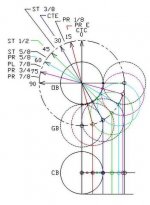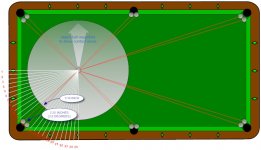LAMas -- I certainly do admire your persistence in looking for alternatives.
With your no-shift/no-pivot "phase shift" approach, are you really now talking about secondary alignment lines, or just single alignment lines. In other words, are you still sighting CTE plus those other lines, or are you kind of ignoring the CTEL and just sighting the other, single line. Certainly for the last few alignments, I doubt you could simultaneously sight two lines, as the CTE would want to be way off into space past the OB.
So it kind of sounds to me like you're just arriving at a straightforward x-angle aiming system where you aim the edge of the CB at one of 8 reference points on the OB: 1/4, 3/8, 1/2, 5/8, 3/4, 7/8, 15/16, and edge-to-edge. So that would give you 8 cut angles in each direction, plus straight.
If you tried to overlay this on top of, say, Stan's CTE method, producing offsets and pivots for some shots but not others, I think it might be hopelessly difficult to discern, distinguish, and implement all of the menu choices it would present.
I address the pre shot as with other aiming methods like DD by lining the CB in front of the OB and establish that line which can be center to center or center to edge (CTE) or center to GB to establish the cut angle to the pocket/target. Since a user of CTE cannot see the GB :wink:, I am using CTE for it is midway between thick and thin cuts, whereas C to C is more at the thick cuts.
I then proceed to establish the secondary aim line from the edge of the CB to the fractional points on the OB. I use stick aiming oon this line and even close the other eye to verify (which eye is aiming) so that I am at the position/stance directed by my aiming eye. I still do not see the utility of using the CTEL after that. Other CTE experts have directed to roatate the body and eyes at 45 degrees to see both lines, but I cannot do that due to double parallax - I have enough problems with single parallax.:wink:
I stand square to the shot with the cue between both under the center of my chin. My eyes happen to be 2.25" apart (diameter of a pool ball) so my cue is stroking 1.125 (half ball) to the side of the secondary aim line below my aiming eye. This give me a consistent stance and a geometry that I can diagram in ACAD.
"...So that would give you 8 cut angles in each direction, plus straight.", I also add the CTE line that is the ubiquitous 30 degree cut angle along with the straight in C to C like Hal.
The other half of this study, for cuts to the left, is the opposite 1/2 tip offset to the right and pivoting left that yields the following going to aim spots on the OB from left to right:
Edge = 16 degrees
1/8 = 20 deg
1/4 = 24 deg
3/8 = 28 deg
1/2 = 32 deg (same as 1/4 no pivot)
5/8 = 36 deg
3/4 = 41 deg
7/8 = 43 deg ( same as 1/4 pivot right)
8/8 Edge = 52 deg
There is generally, cut angles every 4 degrees apart that may be good enough for OB near the 4.5" wide pocket.
Thanks for your interest.
Last edited:

